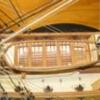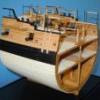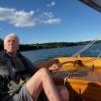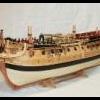MORE HANDBOOKS ARE ON THEIR WAY! We will let you know when they get here.
×
-
Posts
1,197 -
Joined
-
Last visited
Reputation Activity
-
 Stuntflyer got a reaction from yvesvidal in Sloop Speedwell 1752 by Stuntflyer (Mike) - Ketch Rigged Sloop - POF
Stuntflyer got a reaction from yvesvidal in Sloop Speedwell 1752 by Stuntflyer (Mike) - Ketch Rigged Sloop - POF
As you know, Chuck faired the hull with the top jigs in place. After supporting the hull with some planking, he was able to remove the jigs and add the fairing caps for both shape and support. Through hands on experience he knows that this approach will work out nicely. I wasn't so sure that it would work out the same for me. I was concerned that after removing the top timber jigs, I would find myself having to fair the hull a lot more. This would be quite difficult with the planking already on the hull. With that in mind, I decided to take a different approach.
I added a chock between each frame where they would be covered by planking. Adding the chocks meant that I could pull the laser cut top timber jigs (before doing any planking) while maintaining support for the frames. After adding the fairing caps, I could fair the hull more accurately at the shear. Generally this turned out to be true at least for me. There were some areas at the shear that needed more work, but an inch or so below the shear the fairing work was good. Yes, a few hours of extra work that turned out well in the end.
Notice that there is still enough room for the .025" cap rail to sit just below the top of the transom.
There was an enormous amount of work needed to fair these aft cants. It took me the better part of three days. Remember this is boxwood, not AYC. Anyway that's done now.😁
Mike
-
 Stuntflyer got a reaction from FrankWouts in Sloop Speedwell 1752 by Stuntflyer (Mike) - Ketch Rigged Sloop - POF
Stuntflyer got a reaction from FrankWouts in Sloop Speedwell 1752 by Stuntflyer (Mike) - Ketch Rigged Sloop - POF
As you know, Chuck faired the hull with the top jigs in place. After supporting the hull with some planking, he was able to remove the jigs and add the fairing caps for both shape and support. Through hands on experience he knows that this approach will work out nicely. I wasn't so sure that it would work out the same for me. I was concerned that after removing the top timber jigs, I would find myself having to fair the hull a lot more. This would be quite difficult with the planking already on the hull. With that in mind, I decided to take a different approach.
I added a chock between each frame where they would be covered by planking. Adding the chocks meant that I could pull the laser cut top timber jigs (before doing any planking) while maintaining support for the frames. After adding the fairing caps, I could fair the hull more accurately at the shear. Generally this turned out to be true at least for me. There were some areas at the shear that needed more work, but an inch or so below the shear the fairing work was good. Yes, a few hours of extra work that turned out well in the end.
Notice that there is still enough room for the .025" cap rail to sit just below the top of the transom.
There was an enormous amount of work needed to fair these aft cants. It took me the better part of three days. Remember this is boxwood, not AYC. Anyway that's done now.😁
Mike
-
 Stuntflyer got a reaction from davec in Sloop Speedwell 1752 by Stuntflyer (Mike) - Ketch Rigged Sloop - POF
Stuntflyer got a reaction from davec in Sloop Speedwell 1752 by Stuntflyer (Mike) - Ketch Rigged Sloop - POF
As you know, Chuck faired the hull with the top jigs in place. After supporting the hull with some planking, he was able to remove the jigs and add the fairing caps for both shape and support. Through hands on experience he knows that this approach will work out nicely. I wasn't so sure that it would work out the same for me. I was concerned that after removing the top timber jigs, I would find myself having to fair the hull a lot more. This would be quite difficult with the planking already on the hull. With that in mind, I decided to take a different approach.
I added a chock between each frame where they would be covered by planking. Adding the chocks meant that I could pull the laser cut top timber jigs (before doing any planking) while maintaining support for the frames. After adding the fairing caps, I could fair the hull more accurately at the shear. Generally this turned out to be true at least for me. There were some areas at the shear that needed more work, but an inch or so below the shear the fairing work was good. Yes, a few hours of extra work that turned out well in the end.
Notice that there is still enough room for the .025" cap rail to sit just below the top of the transom.
There was an enormous amount of work needed to fair these aft cants. It took me the better part of three days. Remember this is boxwood, not AYC. Anyway that's done now.😁
Mike
-
 Stuntflyer got a reaction from Seventynet in Sloop Speedwell 1752 by Stuntflyer (Mike) - Ketch Rigged Sloop - POF
Stuntflyer got a reaction from Seventynet in Sloop Speedwell 1752 by Stuntflyer (Mike) - Ketch Rigged Sloop - POF
As you know, Chuck faired the hull with the top jigs in place. After supporting the hull with some planking, he was able to remove the jigs and add the fairing caps for both shape and support. Through hands on experience he knows that this approach will work out nicely. I wasn't so sure that it would work out the same for me. I was concerned that after removing the top timber jigs, I would find myself having to fair the hull a lot more. This would be quite difficult with the planking already on the hull. With that in mind, I decided to take a different approach.
I added a chock between each frame where they would be covered by planking. Adding the chocks meant that I could pull the laser cut top timber jigs (before doing any planking) while maintaining support for the frames. After adding the fairing caps, I could fair the hull more accurately at the shear. Generally this turned out to be true at least for me. There were some areas at the shear that needed more work, but an inch or so below the shear the fairing work was good. Yes, a few hours of extra work that turned out well in the end.
Notice that there is still enough room for the .025" cap rail to sit just below the top of the transom.
There was an enormous amount of work needed to fair these aft cants. It took me the better part of three days. Remember this is boxwood, not AYC. Anyway that's done now.😁
Mike
-
 Stuntflyer got a reaction from KARAVOKIRIS in Sloop Speedwell 1752 by Stuntflyer (Mike) - Ketch Rigged Sloop - POF
Stuntflyer got a reaction from KARAVOKIRIS in Sloop Speedwell 1752 by Stuntflyer (Mike) - Ketch Rigged Sloop - POF
As you know, Chuck faired the hull with the top jigs in place. After supporting the hull with some planking, he was able to remove the jigs and add the fairing caps for both shape and support. Through hands on experience he knows that this approach will work out nicely. I wasn't so sure that it would work out the same for me. I was concerned that after removing the top timber jigs, I would find myself having to fair the hull a lot more. This would be quite difficult with the planking already on the hull. With that in mind, I decided to take a different approach.
I added a chock between each frame where they would be covered by planking. Adding the chocks meant that I could pull the laser cut top timber jigs (before doing any planking) while maintaining support for the frames. After adding the fairing caps, I could fair the hull more accurately at the shear. Generally this turned out to be true at least for me. There were some areas at the shear that needed more work, but an inch or so below the shear the fairing work was good. Yes, a few hours of extra work that turned out well in the end.
Notice that there is still enough room for the .025" cap rail to sit just below the top of the transom.
There was an enormous amount of work needed to fair these aft cants. It took me the better part of three days. Remember this is boxwood, not AYC. Anyway that's done now.😁
Mike
-
 Stuntflyer got a reaction from Mike Y in Sloop Speedwell 1752 by Stuntflyer (Mike) - Ketch Rigged Sloop - POF
Stuntflyer got a reaction from Mike Y in Sloop Speedwell 1752 by Stuntflyer (Mike) - Ketch Rigged Sloop - POF
As you know, Chuck faired the hull with the top jigs in place. After supporting the hull with some planking, he was able to remove the jigs and add the fairing caps for both shape and support. Through hands on experience he knows that this approach will work out nicely. I wasn't so sure that it would work out the same for me. I was concerned that after removing the top timber jigs, I would find myself having to fair the hull a lot more. This would be quite difficult with the planking already on the hull. With that in mind, I decided to take a different approach.
I added a chock between each frame where they would be covered by planking. Adding the chocks meant that I could pull the laser cut top timber jigs (before doing any planking) while maintaining support for the frames. After adding the fairing caps, I could fair the hull more accurately at the shear. Generally this turned out to be true at least for me. There were some areas at the shear that needed more work, but an inch or so below the shear the fairing work was good. Yes, a few hours of extra work that turned out well in the end.
Notice that there is still enough room for the .025" cap rail to sit just below the top of the transom.
There was an enormous amount of work needed to fair these aft cants. It took me the better part of three days. Remember this is boxwood, not AYC. Anyway that's done now.😁
Mike
-
 Stuntflyer reacted to scrubbyj427 in Sloop Speedwell 1752 by Stuntflyer (Mike) - Ketch Rigged Sloop - POF
Stuntflyer reacted to scrubbyj427 in Sloop Speedwell 1752 by Stuntflyer (Mike) - Ketch Rigged Sloop - POF
Lovely work Mike!
-
 Stuntflyer got a reaction from GrandpaPhil in Sloop Speedwell 1752 by Stuntflyer (Mike) - Ketch Rigged Sloop - POF
Stuntflyer got a reaction from GrandpaPhil in Sloop Speedwell 1752 by Stuntflyer (Mike) - Ketch Rigged Sloop - POF
As you know, Chuck faired the hull with the top jigs in place. After supporting the hull with some planking, he was able to remove the jigs and add the fairing caps for both shape and support. Through hands on experience he knows that this approach will work out nicely. I wasn't so sure that it would work out the same for me. I was concerned that after removing the top timber jigs, I would find myself having to fair the hull a lot more. This would be quite difficult with the planking already on the hull. With that in mind, I decided to take a different approach.
I added a chock between each frame where they would be covered by planking. Adding the chocks meant that I could pull the laser cut top timber jigs (before doing any planking) while maintaining support for the frames. After adding the fairing caps, I could fair the hull more accurately at the shear. Generally this turned out to be true at least for me. There were some areas at the shear that needed more work, but an inch or so below the shear the fairing work was good. Yes, a few hours of extra work that turned out well in the end.
Notice that there is still enough room for the .025" cap rail to sit just below the top of the transom.
There was an enormous amount of work needed to fair these aft cants. It took me the better part of three days. Remember this is boxwood, not AYC. Anyway that's done now.😁
Mike
-
 Stuntflyer got a reaction from Alexander Bulimov in Sloop Speedwell 1752 by Stuntflyer (Mike) - Ketch Rigged Sloop - POF
Stuntflyer got a reaction from Alexander Bulimov in Sloop Speedwell 1752 by Stuntflyer (Mike) - Ketch Rigged Sloop - POF
As you know, Chuck faired the hull with the top jigs in place. After supporting the hull with some planking, he was able to remove the jigs and add the fairing caps for both shape and support. Through hands on experience he knows that this approach will work out nicely. I wasn't so sure that it would work out the same for me. I was concerned that after removing the top timber jigs, I would find myself having to fair the hull a lot more. This would be quite difficult with the planking already on the hull. With that in mind, I decided to take a different approach.
I added a chock between each frame where they would be covered by planking. Adding the chocks meant that I could pull the laser cut top timber jigs (before doing any planking) while maintaining support for the frames. After adding the fairing caps, I could fair the hull more accurately at the shear. Generally this turned out to be true at least for me. There were some areas at the shear that needed more work, but an inch or so below the shear the fairing work was good. Yes, a few hours of extra work that turned out well in the end.
Notice that there is still enough room for the .025" cap rail to sit just below the top of the transom.
There was an enormous amount of work needed to fair these aft cants. It took me the better part of three days. Remember this is boxwood, not AYC. Anyway that's done now.😁
Mike
-
 Stuntflyer got a reaction from dvm27 in Sloop Speedwell 1752 by Stuntflyer (Mike) - Ketch Rigged Sloop - POF
Stuntflyer got a reaction from dvm27 in Sloop Speedwell 1752 by Stuntflyer (Mike) - Ketch Rigged Sloop - POF
As you know, Chuck faired the hull with the top jigs in place. After supporting the hull with some planking, he was able to remove the jigs and add the fairing caps for both shape and support. Through hands on experience he knows that this approach will work out nicely. I wasn't so sure that it would work out the same for me. I was concerned that after removing the top timber jigs, I would find myself having to fair the hull a lot more. This would be quite difficult with the planking already on the hull. With that in mind, I decided to take a different approach.
I added a chock between each frame where they would be covered by planking. Adding the chocks meant that I could pull the laser cut top timber jigs (before doing any planking) while maintaining support for the frames. After adding the fairing caps, I could fair the hull more accurately at the shear. Generally this turned out to be true at least for me. There were some areas at the shear that needed more work, but an inch or so below the shear the fairing work was good. Yes, a few hours of extra work that turned out well in the end.
Notice that there is still enough room for the .025" cap rail to sit just below the top of the transom.
There was an enormous amount of work needed to fair these aft cants. It took me the better part of three days. Remember this is boxwood, not AYC. Anyway that's done now.😁
Mike
-
 Stuntflyer got a reaction from mtaylor in Sloop Speedwell 1752 by Stuntflyer (Mike) - Ketch Rigged Sloop - POF
Stuntflyer got a reaction from mtaylor in Sloop Speedwell 1752 by Stuntflyer (Mike) - Ketch Rigged Sloop - POF
As you know, Chuck faired the hull with the top jigs in place. After supporting the hull with some planking, he was able to remove the jigs and add the fairing caps for both shape and support. Through hands on experience he knows that this approach will work out nicely. I wasn't so sure that it would work out the same for me. I was concerned that after removing the top timber jigs, I would find myself having to fair the hull a lot more. This would be quite difficult with the planking already on the hull. With that in mind, I decided to take a different approach.
I added a chock between each frame where they would be covered by planking. Adding the chocks meant that I could pull the laser cut top timber jigs (before doing any planking) while maintaining support for the frames. After adding the fairing caps, I could fair the hull more accurately at the shear. Generally this turned out to be true at least for me. There were some areas at the shear that needed more work, but an inch or so below the shear the fairing work was good. Yes, a few hours of extra work that turned out well in the end.
Notice that there is still enough room for the .025" cap rail to sit just below the top of the transom.
There was an enormous amount of work needed to fair these aft cants. It took me the better part of three days. Remember this is boxwood, not AYC. Anyway that's done now.😁
Mike
-
 Stuntflyer got a reaction from tlevine in Sloop Speedwell 1752 by Stuntflyer (Mike) - Ketch Rigged Sloop - POF
Stuntflyer got a reaction from tlevine in Sloop Speedwell 1752 by Stuntflyer (Mike) - Ketch Rigged Sloop - POF
As you know, Chuck faired the hull with the top jigs in place. After supporting the hull with some planking, he was able to remove the jigs and add the fairing caps for both shape and support. Through hands on experience he knows that this approach will work out nicely. I wasn't so sure that it would work out the same for me. I was concerned that after removing the top timber jigs, I would find myself having to fair the hull a lot more. This would be quite difficult with the planking already on the hull. With that in mind, I decided to take a different approach.
I added a chock between each frame where they would be covered by planking. Adding the chocks meant that I could pull the laser cut top timber jigs (before doing any planking) while maintaining support for the frames. After adding the fairing caps, I could fair the hull more accurately at the shear. Generally this turned out to be true at least for me. There were some areas at the shear that needed more work, but an inch or so below the shear the fairing work was good. Yes, a few hours of extra work that turned out well in the end.
Notice that there is still enough room for the .025" cap rail to sit just below the top of the transom.
There was an enormous amount of work needed to fair these aft cants. It took me the better part of three days. Remember this is boxwood, not AYC. Anyway that's done now.😁
Mike
-
 Stuntflyer got a reaction from CiscoH in Sloop Speedwell 1752 by Stuntflyer (Mike) - Ketch Rigged Sloop - POF
Stuntflyer got a reaction from CiscoH in Sloop Speedwell 1752 by Stuntflyer (Mike) - Ketch Rigged Sloop - POF
As you know, Chuck faired the hull with the top jigs in place. After supporting the hull with some planking, he was able to remove the jigs and add the fairing caps for both shape and support. Through hands on experience he knows that this approach will work out nicely. I wasn't so sure that it would work out the same for me. I was concerned that after removing the top timber jigs, I would find myself having to fair the hull a lot more. This would be quite difficult with the planking already on the hull. With that in mind, I decided to take a different approach.
I added a chock between each frame where they would be covered by planking. Adding the chocks meant that I could pull the laser cut top timber jigs (before doing any planking) while maintaining support for the frames. After adding the fairing caps, I could fair the hull more accurately at the shear. Generally this turned out to be true at least for me. There were some areas at the shear that needed more work, but an inch or so below the shear the fairing work was good. Yes, a few hours of extra work that turned out well in the end.
Notice that there is still enough room for the .025" cap rail to sit just below the top of the transom.
There was an enormous amount of work needed to fair these aft cants. It took me the better part of three days. Remember this is boxwood, not AYC. Anyway that's done now.😁
Mike
-
 Stuntflyer got a reaction from Wahka_est in Sloop Speedwell 1752 by Stuntflyer (Mike) - Ketch Rigged Sloop - POF
Stuntflyer got a reaction from Wahka_est in Sloop Speedwell 1752 by Stuntflyer (Mike) - Ketch Rigged Sloop - POF
As you know, Chuck faired the hull with the top jigs in place. After supporting the hull with some planking, he was able to remove the jigs and add the fairing caps for both shape and support. Through hands on experience he knows that this approach will work out nicely. I wasn't so sure that it would work out the same for me. I was concerned that after removing the top timber jigs, I would find myself having to fair the hull a lot more. This would be quite difficult with the planking already on the hull. With that in mind, I decided to take a different approach.
I added a chock between each frame where they would be covered by planking. Adding the chocks meant that I could pull the laser cut top timber jigs (before doing any planking) while maintaining support for the frames. After adding the fairing caps, I could fair the hull more accurately at the shear. Generally this turned out to be true at least for me. There were some areas at the shear that needed more work, but an inch or so below the shear the fairing work was good. Yes, a few hours of extra work that turned out well in the end.
Notice that there is still enough room for the .025" cap rail to sit just below the top of the transom.
There was an enormous amount of work needed to fair these aft cants. It took me the better part of three days. Remember this is boxwood, not AYC. Anyway that's done now.😁
Mike
-
 Stuntflyer got a reaction from TBlack in Sloop Speedwell 1752 by Stuntflyer (Mike) - Ketch Rigged Sloop - POF
Stuntflyer got a reaction from TBlack in Sloop Speedwell 1752 by Stuntflyer (Mike) - Ketch Rigged Sloop - POF
As you know, Chuck faired the hull with the top jigs in place. After supporting the hull with some planking, he was able to remove the jigs and add the fairing caps for both shape and support. Through hands on experience he knows that this approach will work out nicely. I wasn't so sure that it would work out the same for me. I was concerned that after removing the top timber jigs, I would find myself having to fair the hull a lot more. This would be quite difficult with the planking already on the hull. With that in mind, I decided to take a different approach.
I added a chock between each frame where they would be covered by planking. Adding the chocks meant that I could pull the laser cut top timber jigs (before doing any planking) while maintaining support for the frames. After adding the fairing caps, I could fair the hull more accurately at the shear. Generally this turned out to be true at least for me. There were some areas at the shear that needed more work, but an inch or so below the shear the fairing work was good. Yes, a few hours of extra work that turned out well in the end.
Notice that there is still enough room for the .025" cap rail to sit just below the top of the transom.
There was an enormous amount of work needed to fair these aft cants. It took me the better part of three days. Remember this is boxwood, not AYC. Anyway that's done now.😁
Mike
-
 Stuntflyer got a reaction from KenW in Sloop Speedwell 1752 by Stuntflyer (Mike) - Ketch Rigged Sloop - POF
Stuntflyer got a reaction from KenW in Sloop Speedwell 1752 by Stuntflyer (Mike) - Ketch Rigged Sloop - POF
As you know, Chuck faired the hull with the top jigs in place. After supporting the hull with some planking, he was able to remove the jigs and add the fairing caps for both shape and support. Through hands on experience he knows that this approach will work out nicely. I wasn't so sure that it would work out the same for me. I was concerned that after removing the top timber jigs, I would find myself having to fair the hull a lot more. This would be quite difficult with the planking already on the hull. With that in mind, I decided to take a different approach.
I added a chock between each frame where they would be covered by planking. Adding the chocks meant that I could pull the laser cut top timber jigs (before doing any planking) while maintaining support for the frames. After adding the fairing caps, I could fair the hull more accurately at the shear. Generally this turned out to be true at least for me. There were some areas at the shear that needed more work, but an inch or so below the shear the fairing work was good. Yes, a few hours of extra work that turned out well in the end.
Notice that there is still enough room for the .025" cap rail to sit just below the top of the transom.
There was an enormous amount of work needed to fair these aft cants. It took me the better part of three days. Remember this is boxwood, not AYC. Anyway that's done now.😁
Mike
-
 Stuntflyer got a reaction from yvesvidal in Sloop Speedwell 1752 by Stuntflyer (Mike) - Ketch Rigged Sloop - POF
Stuntflyer got a reaction from yvesvidal in Sloop Speedwell 1752 by Stuntflyer (Mike) - Ketch Rigged Sloop - POF
Window sills
I will admit that these were quite tricky to make. Different angles everywhere and some trial and error was needed in order to get them just right. I probably had 3 or 4 throwaways before getting the ones you see here.
Stern frames
In order to make these, I sandwiched two roughly cut frames together with some Elmer's School Glue and then adhered the plan drawing for final shaping. This was easy enough to do with the help of the spindle sander, disk sander and scroll saw.
Transom
On top of the shear there will be a 5/32" fairing cap and a 1/4" cap rail that sits on top of that. The two pieces will add a total of about 3/32" more height to the top of the shear. I wouldn't want the cap rail to protrude above the top edge of the transom. With that in mind, I decided to fair the quarter deck shear before adding the transom. This way I could check the clearance before adding the transom. It was really just a matter of getting that small triangular piece taken down to the right height while fairing the shear.
I added the 5/32" fairing cap for the quarter deck and faired the outer hull using the cap as a guide.
Mike
-
 Stuntflyer got a reaction from Rustyj in Sloop Speedwell 1752 by Stuntflyer (Mike) - Ketch Rigged Sloop - POF
Stuntflyer got a reaction from Rustyj in Sloop Speedwell 1752 by Stuntflyer (Mike) - Ketch Rigged Sloop - POF
As you know, Chuck faired the hull with the top jigs in place. After supporting the hull with some planking, he was able to remove the jigs and add the fairing caps for both shape and support. Through hands on experience he knows that this approach will work out nicely. I wasn't so sure that it would work out the same for me. I was concerned that after removing the top timber jigs, I would find myself having to fair the hull a lot more. This would be quite difficult with the planking already on the hull. With that in mind, I decided to take a different approach.
I added a chock between each frame where they would be covered by planking. Adding the chocks meant that I could pull the laser cut top timber jigs (before doing any planking) while maintaining support for the frames. After adding the fairing caps, I could fair the hull more accurately at the shear. Generally this turned out to be true at least for me. There were some areas at the shear that needed more work, but an inch or so below the shear the fairing work was good. Yes, a few hours of extra work that turned out well in the end.
Notice that there is still enough room for the .025" cap rail to sit just below the top of the transom.
There was an enormous amount of work needed to fair these aft cants. It took me the better part of three days. Remember this is boxwood, not AYC. Anyway that's done now.😁
Mike
-
 Stuntflyer got a reaction from rcweir in Sloop Speedwell 1752 by Stuntflyer (Mike) - Ketch Rigged Sloop - POF
Stuntflyer got a reaction from rcweir in Sloop Speedwell 1752 by Stuntflyer (Mike) - Ketch Rigged Sloop - POF
As you know, Chuck faired the hull with the top jigs in place. After supporting the hull with some planking, he was able to remove the jigs and add the fairing caps for both shape and support. Through hands on experience he knows that this approach will work out nicely. I wasn't so sure that it would work out the same for me. I was concerned that after removing the top timber jigs, I would find myself having to fair the hull a lot more. This would be quite difficult with the planking already on the hull. With that in mind, I decided to take a different approach.
I added a chock between each frame where they would be covered by planking. Adding the chocks meant that I could pull the laser cut top timber jigs (before doing any planking) while maintaining support for the frames. After adding the fairing caps, I could fair the hull more accurately at the shear. Generally this turned out to be true at least for me. There were some areas at the shear that needed more work, but an inch or so below the shear the fairing work was good. Yes, a few hours of extra work that turned out well in the end.
Notice that there is still enough room for the .025" cap rail to sit just below the top of the transom.
There was an enormous amount of work needed to fair these aft cants. It took me the better part of three days. Remember this is boxwood, not AYC. Anyway that's done now.😁
Mike
-
 Stuntflyer got a reaction from ccoyle in Sloop Speedwell 1752 by Stuntflyer (Mike) - Ketch Rigged Sloop - POF
Stuntflyer got a reaction from ccoyle in Sloop Speedwell 1752 by Stuntflyer (Mike) - Ketch Rigged Sloop - POF
As you know, Chuck faired the hull with the top jigs in place. After supporting the hull with some planking, he was able to remove the jigs and add the fairing caps for both shape and support. Through hands on experience he knows that this approach will work out nicely. I wasn't so sure that it would work out the same for me. I was concerned that after removing the top timber jigs, I would find myself having to fair the hull a lot more. This would be quite difficult with the planking already on the hull. With that in mind, I decided to take a different approach.
I added a chock between each frame where they would be covered by planking. Adding the chocks meant that I could pull the laser cut top timber jigs (before doing any planking) while maintaining support for the frames. After adding the fairing caps, I could fair the hull more accurately at the shear. Generally this turned out to be true at least for me. There were some areas at the shear that needed more work, but an inch or so below the shear the fairing work was good. Yes, a few hours of extra work that turned out well in the end.
Notice that there is still enough room for the .025" cap rail to sit just below the top of the transom.
There was an enormous amount of work needed to fair these aft cants. It took me the better part of three days. Remember this is boxwood, not AYC. Anyway that's done now.😁
Mike
-
 Stuntflyer got a reaction from davyboy in Sloop Speedwell 1752 by Stuntflyer (Mike) - Ketch Rigged Sloop - POF
Stuntflyer got a reaction from davyboy in Sloop Speedwell 1752 by Stuntflyer (Mike) - Ketch Rigged Sloop - POF
As you know, Chuck faired the hull with the top jigs in place. After supporting the hull with some planking, he was able to remove the jigs and add the fairing caps for both shape and support. Through hands on experience he knows that this approach will work out nicely. I wasn't so sure that it would work out the same for me. I was concerned that after removing the top timber jigs, I would find myself having to fair the hull a lot more. This would be quite difficult with the planking already on the hull. With that in mind, I decided to take a different approach.
I added a chock between each frame where they would be covered by planking. Adding the chocks meant that I could pull the laser cut top timber jigs (before doing any planking) while maintaining support for the frames. After adding the fairing caps, I could fair the hull more accurately at the shear. Generally this turned out to be true at least for me. There were some areas at the shear that needed more work, but an inch or so below the shear the fairing work was good. Yes, a few hours of extra work that turned out well in the end.
Notice that there is still enough room for the .025" cap rail to sit just below the top of the transom.
There was an enormous amount of work needed to fair these aft cants. It took me the better part of three days. Remember this is boxwood, not AYC. Anyway that's done now.😁
Mike
-
 Stuntflyer got a reaction from fake johnbull in Sloop Speedwell 1752 by Stuntflyer (Mike) - Ketch Rigged Sloop - POF
Stuntflyer got a reaction from fake johnbull in Sloop Speedwell 1752 by Stuntflyer (Mike) - Ketch Rigged Sloop - POF
As you know, Chuck faired the hull with the top jigs in place. After supporting the hull with some planking, he was able to remove the jigs and add the fairing caps for both shape and support. Through hands on experience he knows that this approach will work out nicely. I wasn't so sure that it would work out the same for me. I was concerned that after removing the top timber jigs, I would find myself having to fair the hull a lot more. This would be quite difficult with the planking already on the hull. With that in mind, I decided to take a different approach.
I added a chock between each frame where they would be covered by planking. Adding the chocks meant that I could pull the laser cut top timber jigs (before doing any planking) while maintaining support for the frames. After adding the fairing caps, I could fair the hull more accurately at the shear. Generally this turned out to be true at least for me. There were some areas at the shear that needed more work, but an inch or so below the shear the fairing work was good. Yes, a few hours of extra work that turned out well in the end.
Notice that there is still enough room for the .025" cap rail to sit just below the top of the transom.
There was an enormous amount of work needed to fair these aft cants. It took me the better part of three days. Remember this is boxwood, not AYC. Anyway that's done now.😁
Mike
-
 Stuntflyer got a reaction from westwood in Sloop Speedwell 1752 by Stuntflyer (Mike) - Ketch Rigged Sloop - POF
Stuntflyer got a reaction from westwood in Sloop Speedwell 1752 by Stuntflyer (Mike) - Ketch Rigged Sloop - POF
As you know, Chuck faired the hull with the top jigs in place. After supporting the hull with some planking, he was able to remove the jigs and add the fairing caps for both shape and support. Through hands on experience he knows that this approach will work out nicely. I wasn't so sure that it would work out the same for me. I was concerned that after removing the top timber jigs, I would find myself having to fair the hull a lot more. This would be quite difficult with the planking already on the hull. With that in mind, I decided to take a different approach.
I added a chock between each frame where they would be covered by planking. Adding the chocks meant that I could pull the laser cut top timber jigs (before doing any planking) while maintaining support for the frames. After adding the fairing caps, I could fair the hull more accurately at the shear. Generally this turned out to be true at least for me. There were some areas at the shear that needed more work, but an inch or so below the shear the fairing work was good. Yes, a few hours of extra work that turned out well in the end.
Notice that there is still enough room for the .025" cap rail to sit just below the top of the transom.
There was an enormous amount of work needed to fair these aft cants. It took me the better part of three days. Remember this is boxwood, not AYC. Anyway that's done now.😁
Mike
-

-

















